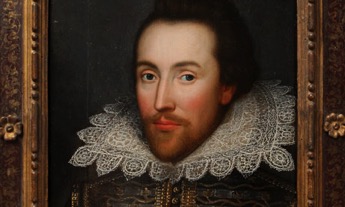Dramaturgical Resources
2015
The Taming of the Shrew
By William Shakespeare
Over the course of the season, our assistant directors and student dramaturgs will be compiling dramaturgical resources relating to each production as it develops. Below are some links to websites which relate to the history of the play, the biography of the playwright, and sites that contextualize and, we hope, shed light on the directorial approach to the dramatic material.
We hope you find these resources of interest.

William Shakespeare (baptized 26 April 1564; b. trad. 23 April 1564 - d. 23 April 1616)
Shakespeare is widely regarded as one of the greatest playwrights of the English language, and his work has been translated and performed worldwide. Born in Stratford-upon-Avon to upper-middle class parents, Shakespeare went on to a career both on and off the stage as an actor and playwright in London.
A Kind of History: Shrews in Folklore and Literature Before Shakespeare
The Taming of the Shrew, like many of Shakespeare’s plays, alludes to folklore that would have been familiar to the audiences of the sixteenth century. The “shrew taming” narrative–where a wealthy man weds a bad-tempered woman only to miraculously transform her into a model wife–would have been one familiar to the bard and his audiences.
Tales such as the ballad “A Merry Jeste” shows the process by which a man would tame an unruly wife. Petruccio’s actions, such as denying Katherina food and sleep and beating his servants in front of her, are certainly milder than those the husband in “A Merry Jeste” inflicts upon his wife, but the parallel is nonetheless clear.
Sly’s story also has a basis in folklore: the beggar turned into a king motif can be found in The Arabian Nights as well as contemporary songs and tales in Shakespeare’s day.
Bianca and her many suitors may allude to George Gascoigne's play, Supposes, written in 1566. Theatre-goers of the day would no doubt have been familiar with the story of a young man who disguises himself in order to woo the beautiful daughter of a wealthy man, if not the play itself.
Shakespeare alludes to other stories in passing for emphasis or to compare characters to established historical figures or tropes. For instance, Petruccio says of Kate in Act 2, Scene 1 that “she will prove a second Grissel, and Roman Lucrece for her chastity” in order to convince Baptista that he and Kate have agreed to marry.
“Grissel” is an allusion to Griselda, the story of a woman whose patience and devotion to her husband was tested through humiliation and isolation. Eventually, Griselda’s husband realizes his wife’s devotion and love, and the couple is reunited. Lucrece was the wife of a Roman nobleman in 509 BCE, who, after being raped, stabbed herself to death and inspired a revolt against the current king of Rome and later inspired Shakespeare’s poem, The Rape of Lucrece.
The encounter between Katherina and Petruccio earlier in 2.1 suggests that Kate is like neither Griselda nor Lucrece, but the use of historic allusion in Petruccio’s comparison is no doubt a tip-off that Petruccio is majorly sucking up to Baptista.
Tranio is changed into Lucentio: Clothing and Social Status
Clothing is mentioned numerous times in The Taming of the Shrew. Shakespeare’s work usually lists only minimal props and costumes, and when it does, these objects often point to an underlying theme within the play (for instance, Twelfth Night features rings and letters, objects that help to advance the humorous confusion of identity and miscommunication that runs through the play).
In the 16th century, clothing was as much a marker of social status as it is today in the 21st century. When characters such as Lucentio and Tranio exchange clothes, they effectively exchange identities, enabling them to move in different social circles than they normally would have.
Christopher Sly, the beggar introduced in the first act of the play, is also another example of the transformative power of clothing in the world of The Taming of the Shrew. Sly’s storyline is never picked up at the end of the play, and the audience may well wonder if he is ever told of the joke that the Lord has played on him.
Not only do the characters exchange identities by changing clothing, they also hide and reveal personality traits. Much of the play’s action is concerned with the keeping up of appearances and how and when characters’ true natures are revealed.
Courtship, Marriage, and Gender Roles in Elizabethan England
Marriage in Shakespeare’s day was often seen as a business deal. Men and women both had rigidly defined gender roles that influenced their education, role in the courtship process, and the marital relationship.
Only sons could inherit. In the event that a family had only daughters, the eldest daughter would inherit – but usually her share of her family’s wealth would go to her husband as a dowry.
In a marriage, men were seen as the providers, while women were in charge of the children and servants. Both boys and girls were educated at home until about seven years of age, then (depending on social class) boys would go to school, while girls continued to be tutored at home.
Stock Characters
Shakespeare would have been familiar with commedia dell’arte, a type of physical, improvisation-based theatre that originated in Renaissance Italy and gained popularity throughout England and France.
In Taming of the Shrew, many of the characters are based upon stock characters from the commedia. Gremio, Bianca’s elderly suitor, is a perfect example of the stock character, Pantaloon, a rich yet foolish old man who is hoodwinked by the young lovers (Inamorati) and their servants/helpers (Zanni, such as Biondello and Grumio).
Other Links
Click here for an NPR interview with Ben Crystal, an actor in charge of The British Library’s recent project to record some of Shakespeare’s most famous scenes with their original pronunciation.
Click here to brush up on meter, verse, prose, and who says what and why.
